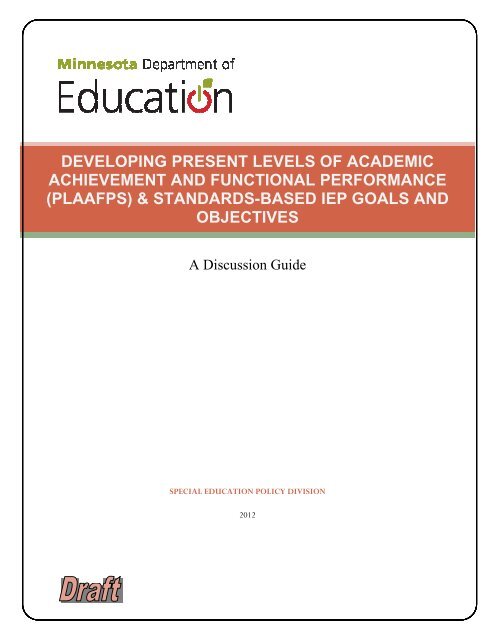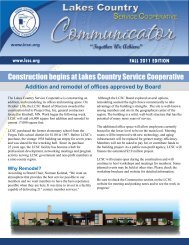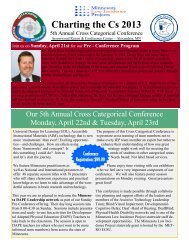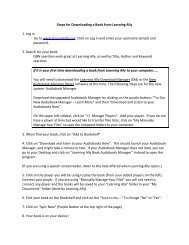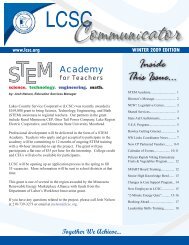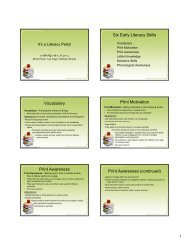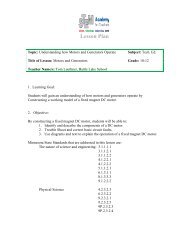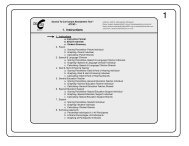PLAAFP Template
PLAAFP Template
PLAAFP Template
You also want an ePaper? Increase the reach of your titles
YUMPU automatically turns print PDFs into web optimized ePapers that Google loves.
DEVELOPING PRESENT LEVELS OF ACADEMICACHIEVEMENT AND FUNCTIONAL PERFORMANCE(<strong>PLAAFP</strong>S) & STANDARDS-BASED IEP GOALS ANDOBJECTIVESA Discussion GuideSPECIAL EDUCATION POLICY DIVISION2012
DEVELOPING PRESENT LEVELS OF ACADEMIC ACHIEVEMENT AND FUNCTIONAL PERFORMANCE (<strong>PLAAFP</strong>S) & STANDARDS-BASED IEP GOALS ANDOBJECTIVES | 4/24/2012DEVELOPING PRESENT LEVELS OFACADEMIC ACHIEVEMENT ANDFUNCTIONAL PERFORMANCE(<strong>PLAAFP</strong>S) & STANDARDS-BASED IEPGOALS AND OBJECTIVESINTRODUCTIONA Discussion GuideBefore an IEP team can develop standards-based IEP goals and objectives designed toimprove a student’s academic achievement, a statement of the student’s present levels ofacademic achievement and functional performance (<strong>PLAAFP</strong>) must first be established.The <strong>PLAAFP</strong> should provide a clear picture of how the student is currently performing inrelationship to their grade-level academic content standards. This allows the IEP team tobetter focus standards-based goals and objectives on those standards with the greatestpotential to accelerate that student’s learning.The questions and discussion prompts in this document have been designed to help developa comprehensive <strong>PLAAFP</strong> statement and related standards-based IEP goals and objectivesin reading and math. The questions can be posed and the prompts discussed in any order,and may be adapted to include additional prompts or other questions to conform to specificdistrict/school’s required IEP forms. Consideration of the questions and discussionprompts will facilitate the development of a <strong>PLAAFP</strong> that lays the groundwork forstandards-based IEP goals and specialized instruction and service planning. For example,responses to some questions may require deeper conversations between a student’s specialeducation teacher and the teacher(s) providing that student’s core instruction. Thoroughreview of the questions and responses will also help the teacher effectively communicatewith parents a student’s performance against grade-level expectations. It is not necessaryto write a response to each prompt, these are just provided to help scaffold discussions. Aspace is provided at the end of each question to make notes that can translate into a<strong>PLAAFP</strong> statement.1
GETTING READY FOR STANDARDS-BASED IEPS: Before the IEP MeetingMembers of the IEP team will want to become familiar with the enrolled grade-levelreading and/or math standards and expectations for the student prior to the IEP teammeeting. If the IEP crosses grade-levels, team members should also review the standardsfor the next grade level to ensure that the team is addressing standards that will continue tobe essential for future grades and post-secondary success.The Minnesota academic content standards for English Language Arts and Mathematicscan be found on the Minnesota Department of Education’s website at this link:http://education.state.mn.us/MDE/EdExc/StanCurri/K-12AcademicStandards/index.htmWhile reviewing the standards note those skills and competencies that appear in multiplestandards and benchmarks. Also consider whether there are standards that are importantto other subjects or content areas that the student will need to master during the year ofthe IEP.Consider the type and level of thinking and reasoning (cognitive complexity) required forthe student to master each standard. Examples of cognitive complexity levels are providedin the MCA and MCA-Modified test specifications on the Minnesota Department ofEducation’s website athttp://education.state.mn.us/MDE/EdExc/Testing/TestSpec/index.htmlIt will also be helpful to have examples of what performance looks like at the student’sgrade level and to think about the pre-requisite skills and understandings necessary toachieve this expected performance. These examples are also useful for explaining gradelevelexpectations to the student’s parents. The new Minnesota Mathematics and ScienceFrameworks at the following website http://www.scimathmn.org/stemtc/ provide examplesof grade-level performance in math for each grade-level standard. Just click on a grade, astandard, and the “Overview” tab to find the section called Big Ideas and EssentialUnderstandings.When IEP Team members are well grounded in the Minnesota academic content standardsfor English Language Arts and Mathematics, they can respond to the questions anddiscussion prompts to follow much more efficiently and effectively.DEVELOPING PRESENT LEVELS OF ACADEMIC ACHIEVEMENT AND FUNCTIONAL PERFORMANCE (<strong>PLAAFP</strong>S) & STANDARDS-BASED IEP GOALS ANDOBJECTIVES | 4/24/20122
DEVELOPING PRESENT LEVELS OF ACADEMIC ACHIEVEMENT AND FUNCTIONAL PERFORMANCE (<strong>PLAAFP</strong>S) & STANDARDS-BASED IEP GOALS ANDOBJECTIVES | 4/24/2012How does the student’s disability affect his/her involvementand progress in the general education curriculum? (34 C.F.R.§ 320(A)(1)(i))Possible Information Sources• Evaluation Report (if current)• Most recent IEP• Input/Feedback from general educationteachers• Observations• Analysis of assessment on state MCA tests• Attendance data• Medical informationDiscussion NotesDiscussion PromptsGiven what we know about thisstudent, what is the impact ofthe student’s disability on:• cognitive ability/basicpsychological processes(consider backgroundknowledge, problemsolving, short-termmemory, visual andauditory processing, longtermmemory storage andretrieval and processingspeed, attention),• academic achievement• social-emotional/behavioralskills,• time spent in instruction,• communication skills,• health and sensory abilities,• ability to function within thegeneral educationenvironment.What special educationinstruction has been provided andwhat progress has been made onIEP goals since the student’s lastIEP (discuss the specific nature ofinstruction, allocated time foreach subcomponent, instructionalvariables, use of technology, etc.vs. location or title of provider)?What has proven effective formaking progress on IEP goalsand in the general educationcurriculum?3
What do we know about this student and how he/she is ableto make progress with his/her own strengths andcompensatory abilities?Discussion PromptsWhere is the student makingprogress or showing strengths?• Consider the instructionalsettings or environmentalvariables that make adifference in performance.• Consider the rate of thestudent’s growth• Consider compensatorystrategies, personalstrengths, etc.What accommodations and/orassistive technologies has thestudent used successfully in thepast?What level of support has beenhelpful to this student?Should the potential for skillregression be considered?What other information shouldbe included to create acomplete picture of how thestudent functions across theschool day and within thespecial education setting?.Possible Information Sources• Input/Feedback from general education• Group discussion of where challenges in learningare not occurring• Observation notes• Most Current IEP goals,• Periodic progress reports• Teachers/parents/student/support staff• Progress monitoring toolsDiscussion NotesDEVELOPING PRESENT LEVELS OF ACADEMIC ACHIEVEMENT AND FUNCTIONAL PERFORMANCE (<strong>PLAAFP</strong>S) & STANDARDS-BASED IEP GOALS ANDOBJECTIVES | 4/24/20124
DEVELOPING PRESENT LEVELS OF ACADEMIC ACHIEVEMENT AND FUNCTIONAL PERFORMANCE (<strong>PLAAFP</strong>S) & STANDARDS-BASED IEP GOALS ANDOBJECTIVES | 4/24/20125What specific data do we have regarding the student’s presentlevels of performance in relationship to the grade-levelstandards?Possible Information Sources• Strand data from MCA and/or NWEA/MAP• Trend data from MCA and/or NWEA/MAP• Evaluation Report (if assessments are tied toacademic curriculum)• Informal assessment measures• Running records• Reading inventories• Classroom observations• Curriculum-based measures• Interview data• Assessment of academic language• Work samplesDiscussion NotesDiscussion PromptsThe data need to be current, valid andreliable, providing convergent evidenceuseful for designing the nextinstructional step.To what extent does the team agree thatthe data are current valid, reliable, etc.?To what extent is the team able tounderstand the student’s currentperformance, given the data?What is the data telling you about howthe student is currently performing?What appears to be constraining thestudent’s growth?Discuss the current performance acrosssub-components for:• reading (phonemic awareness,basic reading skills, readingfluency, reading comprehension,academic language),• writing (handwriting, spelling,written expression),• math (numeracy, computationalfluency, problem solving, etc.)?Are there patterns in the data acrosssources (think of issues with pragmaticlanguage impacting both academics andsocial skills and how both may limitaccess and progress in the generalcurriculum for example ability to workcollaboratively)?What data do you have that can be usedto evaluate the need/effectiveness ofaccommodations and/or assistivetechnologies?
Given the Identified grade-level expectations in reading, and/ormath, what are the most essential grade-level standards andbenchmarks that must be addressed during the year of thisstudent’s IEP?Discussion PromptsBased on your data review, are therepatterns in the data across sources?Think about how pragmatic language mayaffect both academics and social skills, asboth may limit access and progress in thegeneral curriculum (e.g., the ability towork collaboratively).What appears to be constraining growthsuch that progress in one sub-skill isrequired to make progress in another?Are there pre-requisite skills that thisstudent must have?Are there skills or competencies that showup in multiple standards or other contentareas?Are there standards that appear to behigh-leverage for this student? You willwant to focus IEP goals and specializedinstruction on the standards most closelytied to the student’s area(s) of greatestneed.Transition-Age Students: What skills orcompetencies will be beneficial for thisstudent to succeed in post-school life?Can they serve a dual purpose--transitionpreparation and progress towardsstandards?Are there non-academic barriers thatshould be addressed to help this studentmeet the standard(s)? (Consider poorsocial skills, emotional regulation,problem solving, communication, etc.)Possible Information Sources• Minnesota state standards• Examples of grade-level expectations• District learner outcomes• General education teachers andadministrators• District curriculum frameworks/rubricsDiscussion NotesDEVELOPING PRESENT LEVELS OF ACADEMIC ACHIEVEMENT AND FUNCTIONAL PERFORMANCE (<strong>PLAAFP</strong>S) & STANDARDS-BASED IEP GOALS ANDOBJECTIVES | 4/24/20126
DEVELOPING PRESENT LEVELS OF ACADEMIC ACHIEVEMENT AND FUNCTIONAL PERFORMANCE (<strong>PLAAFP</strong>S) & STANDARDS-BASED IEP GOALS ANDOBJECTIVES | 4/24/2012What other educationally relevant needs resulting from thestudent’s disability must be addressed, but not necessarilytied to standards?Possible Information SourcesBehavior• Discipline data• Attendance data• Functional Behavior Assessments• Observations• Outside service providers• Classroom teachers• Mental health screening information• Medical informationTransition Data• Transition evaluations, assessment/inventories• Vocational assessmentFunctional Skills• Evaluation Report (adaptive functioning,organizational checklists, related serviceprovider reports, etc.)Organization and Study Skills (illustratingindependent classroom functioning)Discussion NotesDiscussion PromptsConsider any otherrelevant data that informsneeds that arise from thedisability but are notrelated to academicstandards.What appears to beconstraining independentfunctioning such thatspecially designedinstruction and relatedservices must be provided?7
The IEP Team’s responses to the previous questions and discussion prompts shouldprovide you with the information and data needed to build a comprehensive <strong>PLAAFP</strong>statement from which standards-based IEP goals and objectives can be developed. Space isprovided below for you to draft your <strong>PLAAFP</strong> statement. Only the most essentialinformation from your discussions needs to be included in the <strong>PLAAFP</strong>.Draft <strong>PLAAFP</strong> StatementThe questions and discussion prompts to follow will help you establish standards-basedIEP goals and objectives and determine the best method to use to monitor the student’sprogress in meeting their standards-based IEP goals.DEVELOPING PRESENT LEVELS OF ACADEMIC ACHIEVEMENT AND FUNCTIONAL PERFORMANCE (<strong>PLAAFP</strong>S) & STANDARDS-BASED IEP GOALS ANDOBJECTIVES | 4/24/20128
DEVELOPING PRESENT LEVELS OF ACADEMIC ACHIEVEMENT AND FUNCTIONAL PERFORMANCE (<strong>PLAAFP</strong>S) & STANDARDS-BASED IEP GOALS ANDOBJECTIVES | 4/24/2012Once essential grade-level standards/benchmarks aredetermined, what are the learning progressions* needed toclose the gap between the student’s skill level and grade-levelcontent standards/benchmarks?* a learning progression is a sequenced set of building blocks ( subskills and/or bodies of enabling knowledge)that students must master en route to mastering a more remote standard or curricular aim (adapted fromPopham, 2012).Possible Information Sources• Minnesota academic content standards• Student’s <strong>PLAAFP</strong>• General education teachers• District curriculum frameworks/rubrics• Scope and sequence documents• MDE MCA Item SamplersDiscussion NotesDiscussion PromptsWhere is the studentcurrently functioningrelative to the essentialstandards?What are the prerequisiteskills/understandings thatthis student must have inorder to meet thestandards/benchmarks?What are the learningprogressions or taskanalyses steps needed tomove the student closer tothe grade-levelstandards/benchmarks?How can the teacher useinstruction, curriculumand environment toaccelerate the student’slearning?What accommodationsand/or assistivetechnologies wouldmitigate the effect of thestudent’s disability andwould help the studentcompensate within theincreasing demands of thegrade-level curriculum?9
How much growth do we expect this student to make towardmeeting the essential standard(s) within the year of the IEP;and how will the student’s progress be measured on aregular basis?Discussion PromptsWhat data gives an indication ofthis student’s previous rate ofgrowth? Consider prior year’sprogress monitoring data, numberof attempts or time to move fromsupported to independent practiceon similar goals (refer back todata).What existing data system(s) andprocesses are currently in placethat would be useful to monitorprogress toward this goal?Consider using classroom-basedformative assessment strategiessuch as unit tests, informalinventories, work samples andweekly quizzes, when no formalprogress monitoring system orprocess will give you the data thatyou need to monitor the student’sgrowth toward the goal.Note: Since you must documentthat the student is highly unlikely toachieve grade-level proficiencyduring the year of the IEP to beeligible to take the MCA-Modified,the team must estimate the growththat is reasonable for the student.Note: Standards-based IEP goalsshould not be a simple reiterationof the grade-levelstandard/benchmark.Possible Information Sources• Strand data from MCA and/or NWEA/MAP• Trend data from MCA and/or NWEA/MAP• Evaluation Report (if current)• Informal assessment measures• Math fluency measures• Classroom observations• Curriculum-based measuresDiscussion NotesDEVELOPING PRESENT LEVELS OF ACADEMIC ACHIEVEMENT AND FUNCTIONAL PERFORMANCE (<strong>PLAAFP</strong>S) & STANDARDS-BASED IEP GOALS ANDOBJECTIVES | 4/24/201210
DEVELOPING PRESENT LEVELS OF ACADEMIC ACHIEVEMENT AND FUNCTIONAL PERFORMANCE (<strong>PLAAFP</strong>S) & STANDARDS-BASED IEP GOALS ANDOBJECTIVES | 4/24/2012Based on the needs identified in the <strong>PLAAFP</strong>, developmeasurable annual standards-based and non-academicgoals in the table below.Remember, SMART goals are Specific, Measurable, Achievable, Results-oriented and Time-bound.Measurable annual goals should include; 1) Who (the student), 2) Behavior (will do what), 3) Criterion(to what level or degree), 4) Conditions (under what conditions or timeframe).Goal I:Objective 1:Objective 2:Objective 3:Goal II:Objective 1:Objective 2:Objective 3:Goal III:Objective 1:Objective 2:Objective 3:Goal IV:Objective 1:Objective 2:Objective 3:11


